Ferenc Farkas: Orchestral Music, Volume Two
This second release in a series of recordings of orchestral music by the Hungarian composer Ferenc Farkas (1905-2000) — this time featuring works for strings — highlights the characteristics that make his music so appealing: catchy tunes, transparent scoring, buoyant rhythms and a fondness for Baroque forms and folk-dances.
Gyula Stuller, violin
János Rolla, violin
László Tóth, trumpet
Franz Liszt Chamber Orchestra, chamber orchestra
Listen To This Recording:
-
Choreae hungaricae: Three Cycles of Hungarian Dances from the 17th Century for string orchestra, Part II: Five Dances from the Kájoni Codex (1961)
- I Moderato
- II Lo stesso tempo
- III Quasi minuetto
- IV Allegro
- V Lo stesso tempo
- I Allegro moderato
- II Lo stesso tempo
- III Andante moderato
- IV Lo stesso tempo
- V Allegro
- VI Lo stesso tempo
- Aria e rondo all’ungherese for two violins and string orchestra (1994)
- I Toccata
- II Aria
- III Fuga
- I Er macht sich auf den Weg
- II Ali Hussein
- III Fu-Kong
- IV Kwanga
- V Rámáyun
- VI Auf dem Heimweg
- I Allegro
- II Andante moderato
- III Allegro
- I Askulan nelio?
- II Palpankilli
- III Melkutus
- IV Lintunen
- V Vanna piika
- VI Haili –
- VII Kumerus
- I Basse danse
- II Gagliarda
- III Passamezzo
- IV Saltarello
- V Intermezzo
- VI Hajdútánc
Choreae hungaricae: Three Cycles of Hungarian Dances from the 17th Century for string orchestra, Part III: Six Dances from the Lőcse Tabulaturbuch (1961)
Musica pentatonica for string orchestra (1945)
András Jelky: Suite for string orchestra and piano (1973–74)
Concertino for trumpet and string orchestra (1984)
Finnish Popular Dances for string orchestra (1935)
Partita all’ungaresca: Hungarian Dances and Tunes from the 16th Century for string orchestra (1974)
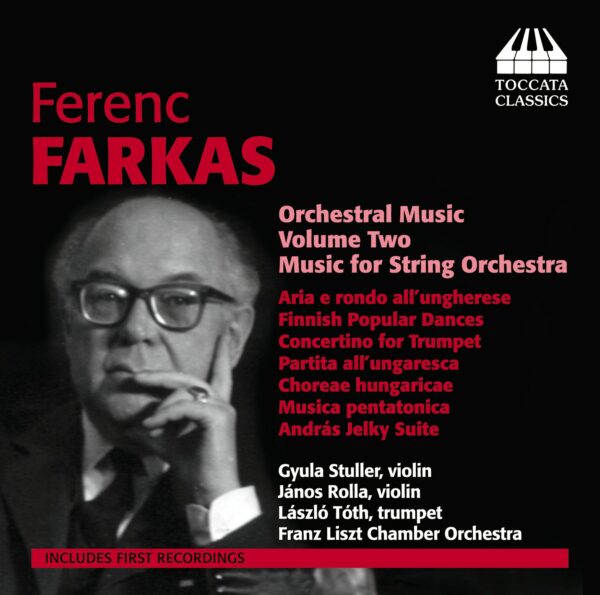
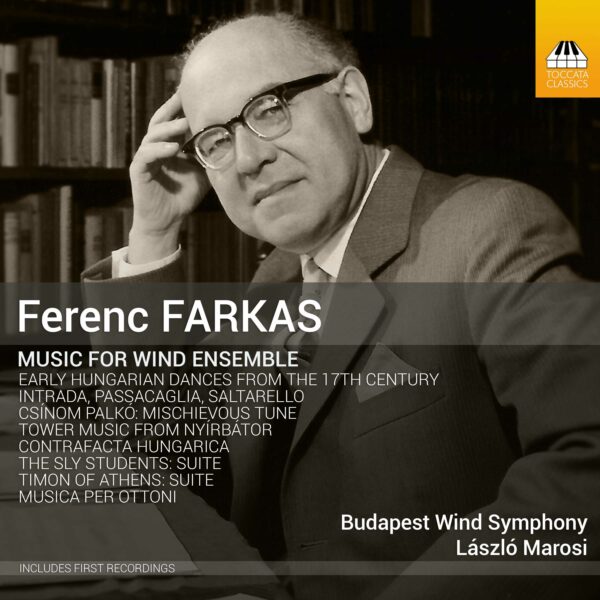
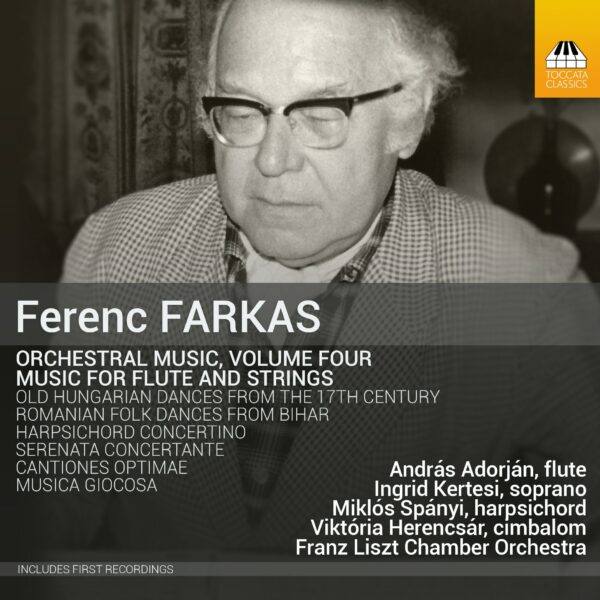
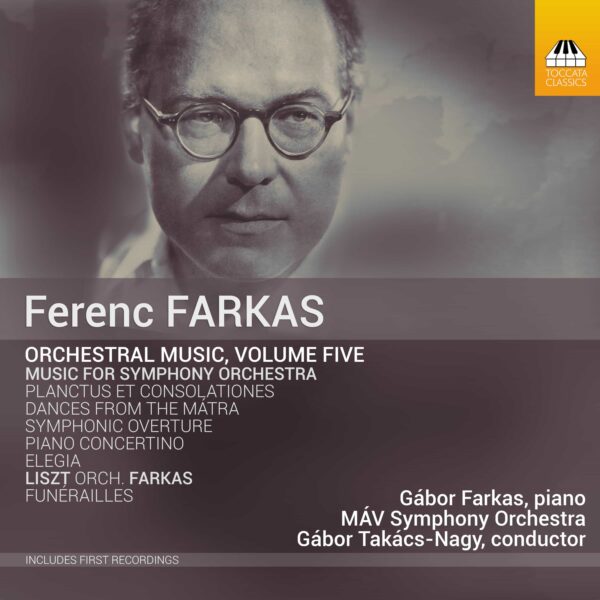
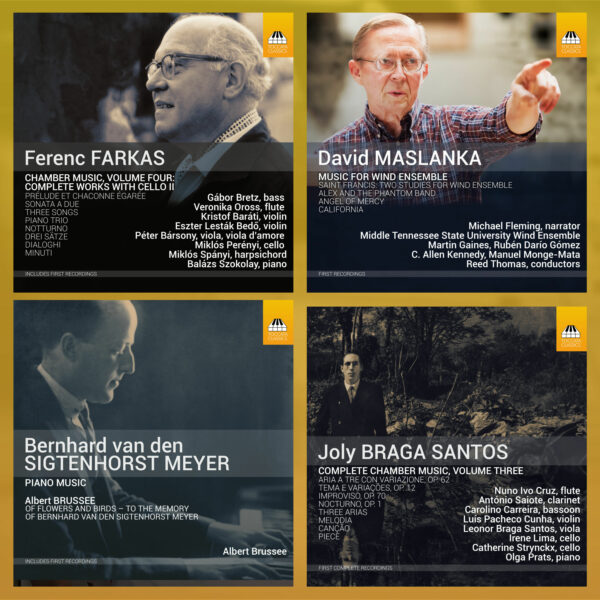
MusicWeb International :
‘…The Chorea Hungaricae is a 1961 reworking for chamber orchestra of some seventeenth-century dance tunes … These attractive pieces often have harmonised melodies courtesy of Farkas. The easy-going Aria e rondo all’ungherese takes anonymous eighteenth-century melodies and serves them up, sweetly lyrical, for the two violin soloists. …A starker impression is left by the early Musica pentatonica which explores elements of twelve-tone though cast in baroque-form movements – Toccata, Aria and Fuga. There’s a vague hint of chinoiserie in the central Aria and the fugue is crisp and springy. …Rhythmically exciting, there’s a lot of Hungarian folk ethos throughout, as well as local colour as he journeys far and wide. Some non-traditional techniques, such as using the bow against the body of the violins, add zest. The Concertino for trumpet (1984) is couched in sonata form, typically concise, and well-orchestrated and well-scaled for the forces concerned. The best movement is the central one of three, a quite spare meditation of some spiritual depth. …The music throughout is performed with warmth and buoyancy in a well-judged acoustic of the Italian Cultural Centre in Budapest. It is fatal to listen to too much in one go, especially the suite-like material. Taken as nourishment, slice by slice, these genial and mostly undemanding confections will prove enjoyable, though hardly indispensable.’
—Jonathan Woolf, MusicWeb International
Classical CD Review :
‘…This delightful disk on Toccata Classics offers three cycles of Hungarian Dances from the 17th Century and various other chamber works mostly scored for two violins plus a trumpet concerto, scored for a small ensemble.This music is charming indeed, reminiscent of Respighi’s set of Ancient Airs and Dances (Farkas studied with Respighi). These performances are wonderful in every way, and the Franz Liszt Orchestra could not be bettered. Excellent sound as well—a superb CD featuring a number of world premiere recordings.’
—Robert Benson, Classical CD Review
Fanfare Magazine :
‘…Respighi, it will be recalled, based those three orchestral suites largely on Renaissance lute music, and in them, he treated the source material with respect, seasoning it only very mildly with 20th-century harmonies, textures, and timbres. Farkas does the same in the Choreae hungaricae, except he is even more frugal with the seasonings, and he draws from Hungarian sources, including the Codex Vietoris, the Codex Caioni, and the Lőcse Tablature Book. The Partita all’ungherese also uses ancient Hungarian music, and the Finnish Popular Dances do the same with old Finnish music. …As a composer, Farkas was more than an affectionate borrower of goodies from the past. He was a polystylist, and he kept up to date with musical trends and experiments running their courses just west of Hungary. Musica pentatonica, as its name suggests, uses only a pentatonic scale, or more accurately, several pentatonic scales, as Farkas changes the root of the scales as the work progresses. Thus, what could have sounded simplistic or naïve remains interesting throughout the work’s three movements and nearly 10-minute length. The concertino for trumpet and string orchestra is fresh and modern and not at all academic. I was reminded of Hindemith and Bloch and Martinů, although Farkas imitated none of those composers in this work. The soloist is excellent. …I think you will find yourself on happily familiar ground with this new release. Recommended. Now to find Volume One!…’
—Raymond Tuttle Fanfare Magazine
Fanfare Magazine :
‘…Farkas is transparent in structure and harmony. He usually prefers small forms and laconic statements, and avoids sweeping, theatrical gestures. A traditionally-minded craftsman, Farkas saw nothing wrong in creating something new out of materials from another age—anywhere from the 16th through 19th centuries, and usually (though not always) based on Hungarian originals. He either stayed meticulously within the stylistic framework of a given period and place, or refracted it through a Neoclassical sensibility. His expressive range was broad, from Neo-Romantic warmth to astringent, non-systematic atonality, but expressiveness remained always to the fore. His music never sounds withdrawn and hermetic, even when its purpose is clearly didactic. …The Franz Liszt Chamber Orchestra … is among the finest ensembles of its kind, possessing precision and great tonal variety. Here they do justice to the composer’s whimsy and sparkling wit… There’s a lot of potential airplay on this album, and a fine introduction to the accessible but varied art of Farkas.’
—Barry Brenesal, Fanfare Magazine
International Record Review :
‘This second volume of music by Ferenc Farkas […]shows two facets of the composer:’One is that of a twentieth-century composer who tried, in the language of his own time, to write music intended to be as widely accessible as possible; the other is that of a master-craftsman whose arrangements breathed new life into the old national music are intermingled; Farkas’s reworkings of seventeenth-century Hungarian dances in Choreae hungaricae, for example, are both exquisitely done and extremely conventional in their neo-Baroque elegance. I would say much the same of the two other dances suites recorded here, distant though they are from each other chronologically […]
The all-Hungarian performances are excellent and the recording is extremely clear.’
—Ivan Moody, International Record Review, November 2014